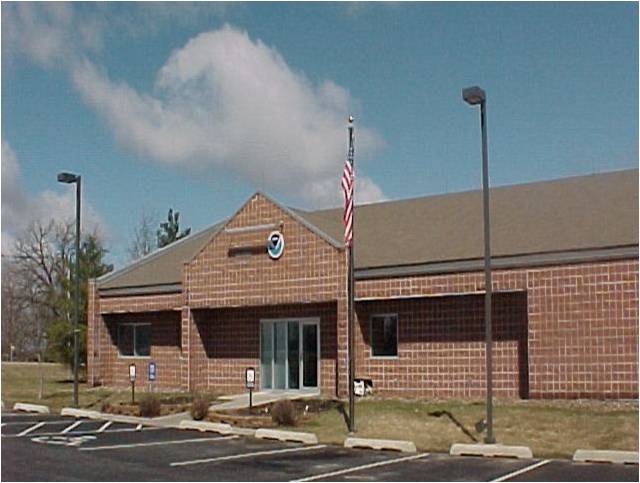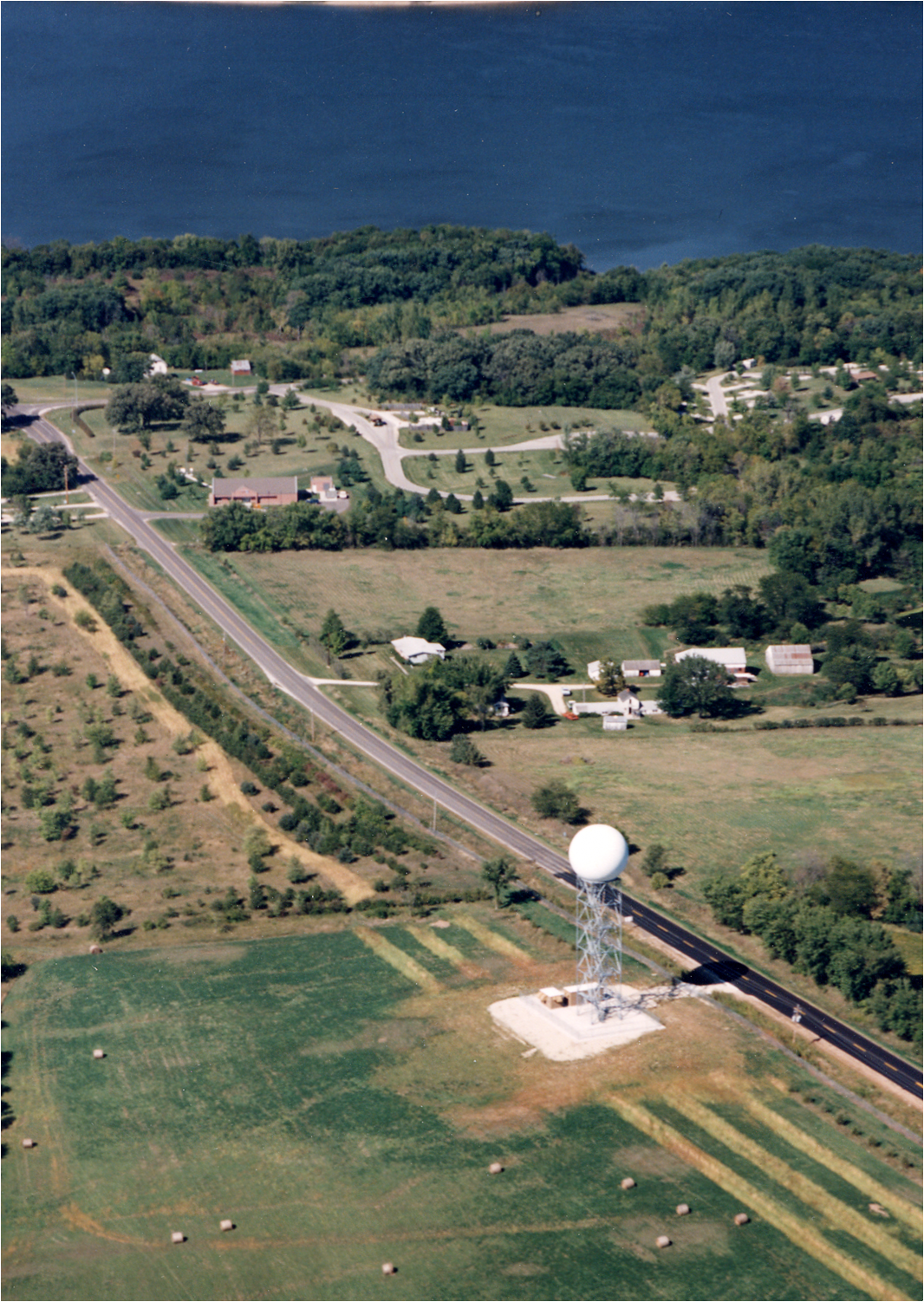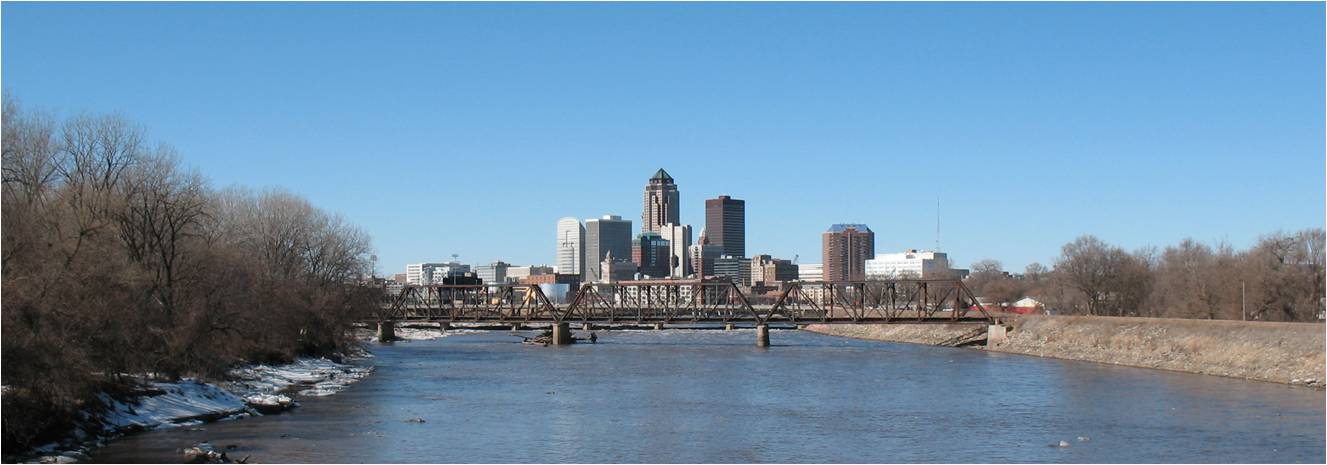Station Digest History of the OfficeOfficial weather observations in Des Moines began on August 1st, 1878 when the Weather Bureau was part of the U.S. Army Signal Corps. The first weather office opened in the northwest room of a two story building known as the George D. McCaine Block, which was located on the northeast corner of Sixth and Walnut streets. The Iowa State Director of Weather and Chief Meteorologist at the time was Dr. Gustavus Hinrichs. On January 1st, 1887 the office moved to the four-story Clapp Block building on the southwest corner of Fifth and Walnut streets, and on April 1st, 1889 moved again to the fourth floor of the U.S. Courthouse and Post Office on the northeast corner of Fifth and Court streets. When a new U.S. Courthouse was completed on the southeast corner of East First and Walnut streets in 1929, the Weather Bureau moved into rooms 400-404 on October 1st of that year. On October 16th, 1950 the office moved to the second floor of the Des Moines Airport Terminals near the corner of Army Post Road and Fleur Drive, where it would remain for more than 40 years. In 1970 the U.S. Department of Commerce was reorganized, and the Weather Bureau officially became the National Weather Service (NWS) on October 3rd, moving under the jurisdiction of the National Oceanic and Atmospheric Administration (NOAA). On September 1st, 1993 the office moved to its current location at 9607 Northwest Beaver Drive in Johnston, on the northwestern edge of the Des Moines metro area. In January 1998 Brenda Brock became the eleventh meteorologist-in-charge of the NWS in Des Moines since observations began in 1878.
NWS Des Moines area of responsibility (county warning area) What we do:The NWS Warning and Forecast Office (WFO) Des Moines serves the central half of Iowa, providing warnings, watches, and forecasts for the protection of life and property per our Mission Statement. Our office collects weather observations and issues public forecasts, watches, warnings, advisories, and other weather-related products for 51 counties in central Iowa. We also issue terminal aerodrome forecasts for five local airports, fire weather forecasts for government and commercial interests, and have a full-service hydrology program. We have 24 staff members, including ten full-time forecasters and four data acquisition personnel. Our weather-observing equipment includes a WSR-88D Doppler radar, 14 NOAA Weather Radio transmitters, and dozens of river gauges and automated surface observation sites. We also maintain an active public outreach program, including cooperative weather observers, trained storm spotters, and CoCoRAHS observers, as well as interacting with the general public at local events. Our office maintains close involvement with local scientific organizations (such as the National Weather Association and various groups affiliated with Iowa State University), media outlets, and law enforcement and emergency management personnel (including the state emergency operations center).
NWS Des Moines office and radar, with Saylorville Lake in the background Office Staff
About the areaThe Des Moines metropolitan area encompasses portions of four counties in central Iowa – Polk, Warren, Madison, and Dallas. The majority of the city and population are located within Polk County. Population:As of the 2000 census there were 456,022 people living within the metro area, with 198,682 of those living within the city limits of Des Moines itself. In 2007 the metro population was estimated to have grown to over 520,000, and is projected to exceed 770,000 by 2025. The population is nearly 80% Caucasian, but there are several notable immigrant communities including those of recent southeastern Asian, Hispanic, and eastern European descent.
Housing:Housing is readily available in the form of single-family homes, condominiums, duplexes, rental apartments, etc. In January 2009, the median price range for an existing single-family residence in the Des Moines metro area was $150,000 to $200,000. Real estate values in central Iowa are much less volatile than in other parts of the country. Property tax/sales tax/income tax info:- Property taxes in central Iowa are based on a valuation roll-back and owners are allowed a homestead exemption of $4850. Taxes for a $150,000 home in central Iowa range from around $2,100 to $3,000 per year for FY 2009.- Iowa has a state sales tax of 5%. In addition, several counties around the state are authorized to collect a local options tax, generally 1-2%. Polk County currently has a 1% local options tax, for a total sales tax of 6%. - Iowa income tax is on a graduated scale. Tax rates begin at 0.36% for any income over zero, and climb to 8.98% on all income amounts above approximately $60,000. Federal tax deductibility is allowed for Iowa taxes. Education:- Iowa State University is located in Ames, approximately 30 miles north of Des Moines. Simpson College is located in Indianola, approximately 15 miles south of Des Moines. Drake University, Grand View University, and the Des Moines Area Community College are all located within the Des Moines metro area. - Public schools within the city of Des Moines have over 30,000 students enrolled in 63 schools for the 2008-09 school year. Transportation:- Interstates 80 and 35 pass through Des Moines, providing convenient vehicular access to the rest of the region and country. Interstate 235 also cuts through the city. Economy:- Des Moines is a major regional and national center for the insurance, financial services, and publishing industries. Agriculture is also a mainstay of the Iowa economy.- In 2000 the median household income within the metro area was $44,667 and the median family income was $52,617.
Iowa State Fair
A hiking trail in western Iowa Recreation:- The Des Moines area offers countless parks with opportunities for camping, hiking, biking, fishing, and other outdoor activities. Saylorville Lake, located just north of the city (and about a mile from the NWS office), is also a popular destination for water sports and birding. Climate:Located in the heart of North America, Des Moines has a climate which is continental in character. This results in a marked seasonal contrast in both temperature and precipitation. Because agriculture is the primary and traditional economic engine of the region, it is convenient to separate the year into seasons corresponding to the growing of crops. The winter season, when most plant life is dormant, is from mid-November to late March. The summer season, when corn and soybeans are grown, lasts from early May to early October. The spring growing season and the fall harvest season each run about 6 weeks. Annual precipitation can vary anywhere from a minimum of about 17 inches to a maximum of about 56 inches. The average annual snowfall is 36 inches. Annual variation of snowfall is also large, ranging from a minimum of about 8 inches to as much as 72 inches. Winter is a season of cold dry air much of the time, interrupted by milder Pacific air brought in by the Chinook winds out of the northern Rockies. Winter storms of short duration are an occasional occurrence. At the beginning and end of the winter season precipitation may occur as rain, but during the heart of the season it mainly falls as snow. Drifting snow can be extensive and impede transportation at times, especially in rural areas. Freezing rain, though not rare, seldom accumulates to a thickness of one quarter of an inch or more. The average precipitation during winter is approximately 20 percent of the annual amount. Although occasional cold waves follow the storms, bitterly cold days on which the temperature fails to rise above zero occur on an average of only once every 2 to 3 years. The average growing season (when temperatures remain above 32 degrees) normally spans 160 to 165 days between late April and mid-October. The growing season is characterized by prevailing southerly winds and precipitation falling primarily as showers and thunderstorms, occasionally producing damaging wind, erosive downpours or hail. Some 60 percent of the annual precipitation amount falls in the summer with the maximum rate normally in late May and June. Autumn is characteristically sunny with diminishing precipitation and generally decreasing temperature, conditions favorable for drying and harvesting crops. Useful Web Links:Information on the Des Moines metro area and nearby cities can be found at the following URLs:-Des Moines http://www.city-data.com/city/Des-Moines-Iowa.html -Ankeny http://www.city-data.com/city/Ankeny-Iowa.html -Urbandale http://www.city-data.com/city/Urbandale-Iowa.html -West Des Moines http://www.city-data.com/city/West-Des-Moines-Iowa.html -Johnston http://www.city-data.com/city/Johnston-Iowa.html -Polk City http://www.city-data.com/city/Polk-City-Iowa.html -Grimes http://www.city-data.com/city/Grimes-Iowa.html
|




